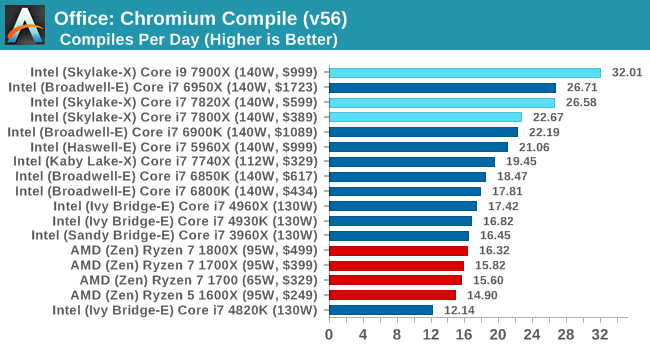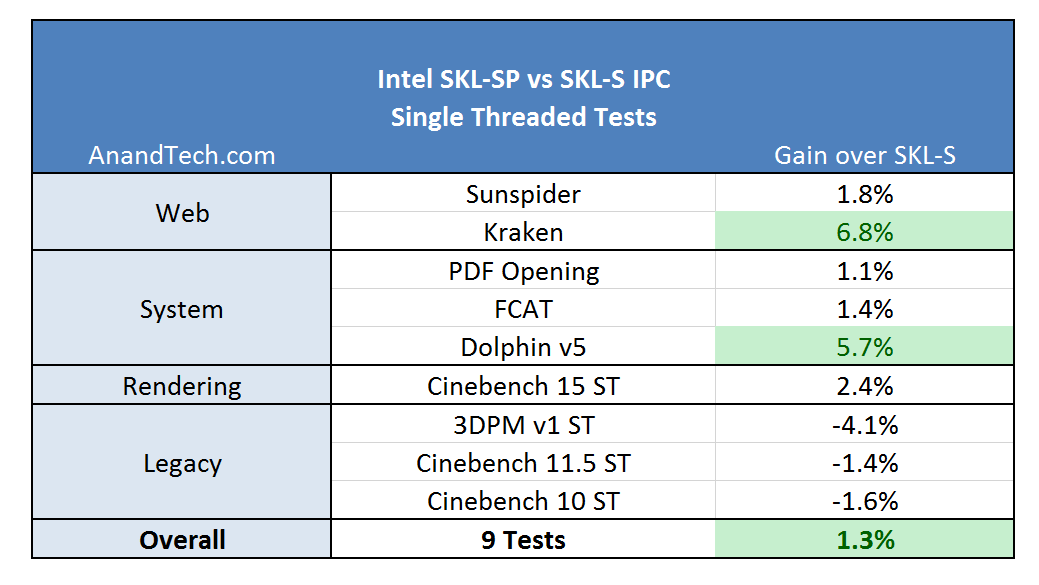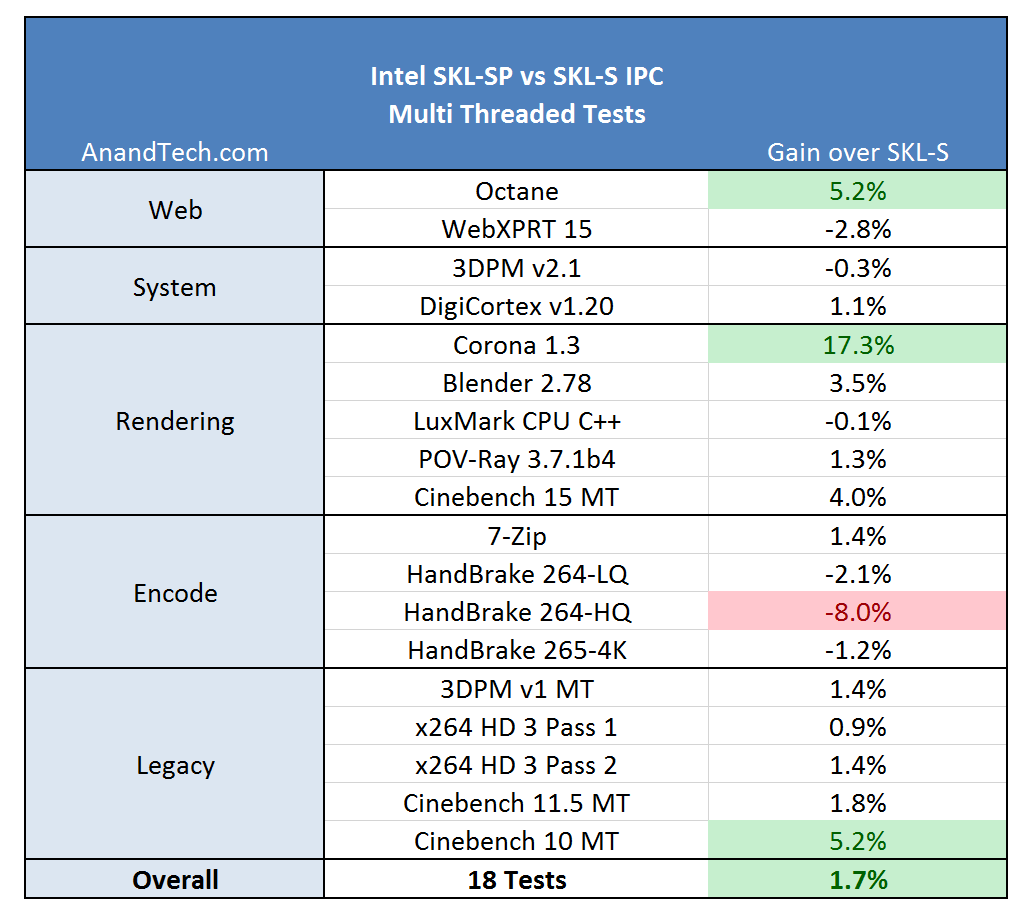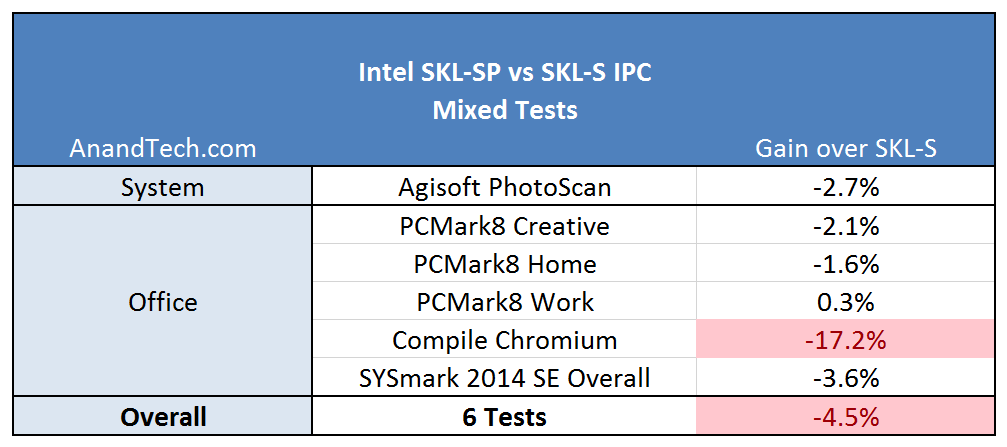The Intel Skylake-X Review: Core i9 7900X, i7 7820X and i7 7800X Tested
by Ian Cutress on June 19, 2017 9:01 AM ESTComparing Skylake-S and Skylake-X/SP Performance Clock-for-Clock
If you’ve read through the full review up to this point (and kudos), there should be three things that stick in the back of your mind about the new Skylake-SP cores: Cache, Mesh and AVX512. These are the three main features that separate the consumer grade Skylake-S core from this new core, and all three can have an impact in clock-for-clock performance. Even though the Skylake-S and the Skylake-SP are not competing in the same markets, it is still poignant to gather how much the changes affect the regular benchmark suite.
For this test, we took the Skylake-S based Core i5-6600 and the Skylake-SP based Core i9-7900X and ran them both with only 4 cores, no hyperthreading, and 3 GHz on all cores with no Turbo active. Both CPUs were run in high performance modes in the OS to restrict any time-to-idle, so it is worth noting here that we are not measuring power. This is just raw throughput.
Both of these cores support different DRAM frequencies, however: the i5-6600 lists DDR4-2133 as its maximum supported frequency, whereas the i9-7900X will run at DDR4-2400 at 2DPC. I queried a few colleagues as to what I should do here – technically the memory support is an extended element of the microarchitecture, and the caches/uncore/untile will be running at different frequencies, so how much of the system support should be chipped away for parity. The general consensus was to test with the supported frequencies, given this is how the parts ship.
For this analysis, each test was broken down in two ways: what sort of benchmark (single thread, multi-thread, mixed) and what category of benchmark (web, office, encode).
For the single threaded tests, results were generally positive. Kraken enjoyed the L2, and Dolphin emulation had a good gain as well. The legacy tests did not fair that great: 3DPM v1 has false sharing, which is likely taking a hit due to the increased L2 latency.
On the multithreaded tests, the big winner here was Corona. Corona is a high-performance renderer for Autodesk 3ds Max, showing that the larger L2 does a good job with its code base. The step back was in Handbrake – our testing does not implement any AVX512 code, but the L3 victim cache might be at play here over the L3 inclusive cache in SKL-S.
The mixed results are surprising: these tests vary with ST and MT parts to their computation, some being cache sensitive as well. The big outlier here is the compile test, indicating that the Skylake-SP might not be (clock for clock) a great compilation core. This is a result we can trace back to the L3 again, being a smaller non-inclusive cache. In our results database, we can see similar results when comparing a Ryzen 7 1700X, an 8-core 95W CPU with 16MB of L3 victim cache, is easily beaten by a Core i7-7700T, with 4 cores at 35W but has 8MB of inclusive L3 cache.
If we treat each of these tests with equal weighting, the overall result will offer a +0.5% gain to the new Skylake-SP core, which is with the margin of error. Nothing too much to be concerned about for most users (except perhaps people who compile all day), although again, these two cores are not in chips that directly compete. The 10-core SKL-SP chip still does the business on compiling:

If all these changes (minus AVX512) offer a +0.5% gain over the standard Skylake-S core, then one question worth asking is what was the point? The answer is usually simple, and I suspect involves scaling (moving to chips with more cores), but also customer related. Intel’s big money comes from the enterprise, and no doubt some of Intel’s internal metrics (as well as customer requests) point to a sizeable chunk of enterprise compute being L2 size limited. I’ll be looking forward to Johan’s review on the enterprise side when the time comes.













264 Comments
View All Comments
AnandTechReader2017 - Tuesday, June 20, 2017 - link
The Chill feature for AMD would probably be amazing for a mini-ITX build. Still waiting on AMD to launch dedicated graphics cards for laptops with it, would be amazing.I hope Nvidia comes up with a similar feature, would make gaming on laptops a lot nicer/quieter.
rocky12345 - Monday, June 19, 2017 - link
"As the first new serious entry into the HEDT space for AMD in almost five years, along with a new x86 core, AMD offered similar-ish performance to Broadwell-E in many aspects (within a few percent), but at half the price or better."Half right it was AMD's first serious entry into High end Mainstream Desktop in five years. We have not seem AMD's HEDT platform in action yet since it has not been released yet. With that said I was surprised how AMD's current Mainstream R7's were able to compete with Intels new HEDT platform so well. If this is what we are to expect from AMD's actual HEDT platform Intel will have a fight on their hands for sure.
I hope when AMD releases their Threadripper platform we get just as an extensive review for that as well. To me it is a lot more exciting to see x399 and threadripper in action than the x299 since Intel has been doing their HEDT platform for many years now and this will be the first time AMD has entered into the same Extreme high end space as Intel at the consumer level hardware.
Manch - Tuesday, June 20, 2017 - link
HEMD? LOLRyzen is a great chip no doubt. AMD is once again pushing Intel to iterate vs stagnate. AMD offers a great price/perf proc. But, AMD brought the comparison on themselves. Most previews were not against a 6700K or 7700K but against Intel's HEDT procs which AMD was clearly targeting with the pre-release benchmark comparos. It is not unfair to compare them.
Braincruser - Monday, June 19, 2017 - link
Any particular reason the mainstream intel processors are not in the benchmarks? One of the more important measurements for me is the difference between the mainstream and high end platforms.Ryan Smith - Monday, June 19, 2017 - link
While we technically have infinite space, we try not to overload the graphs with too many products, focusing on new products and certain generational comparisons. For specific comparisons you'd like to see that aren't in a graph, you can find all of that over in Bench.http://www.anandtech.com/bench/
AnandTechReader2017 - Tuesday, June 20, 2017 - link
Thanks for the link, I didn't know you guys had that.none12345 - Monday, June 19, 2017 - link
Small correction for your article, ryzen 7 has 20 pci lanes not 16. I am NOT counting 4 more for the chipset, if you count those its 24. Youve got 16 to the gpu, and 4 to a direct connected m.2(or 2 sata ports, but usually its a m.2)Tho thats not the whole story. Since technically you dont need the chipset, so you could connect something else instead on those 4 lanes. In the real world tho almost every motherboard will have a chipset there.
And then there are the usb ports which have direct connections on the chip as well. Thats could be counted as more pci lanes if one wanted to. They dont share the chipset link.
So depending on how you count it, its 20, 24, or 28 lanes. I would call it 20 and not count the usb or the chipset ones, but id definitly count the direct connected m.2
Nintendo Maniac 64 - Monday, June 19, 2017 - link
Uhhh, where's the results for Dolphin? It's on the "clock-for-clock" page but not on the "CPU system tests" page...Ro_Ja - Monday, June 19, 2017 - link
It's nice to see the Ryzen Chips keeping up with i9s.Hurr Durr - Tuesday, June 20, 2017 - link
Except they don`t, hence the price difference.